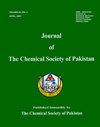不同尺寸AgCIT和AgPVP与其蛋白冠状粒子的生物相容性比较
IF 0.5
4区 化学
Q4 CHEMISTRY, MULTIDISCIPLINARY
引用次数: 0
摘要
纳米粒子的生物相容性对生物医学应用至关重要。以柠檬酸盐和聚乙烯吡咯烷酮(PVP)为包覆层,合成了5 nm、10 nm、20 nm、40 nm和80 nm的纳米银微粒,并对其蛋白冠进行了引物处理。采用紫外可见光谱、动态光散射(DLS)和透射电子显微镜(TEM)对纳米颗粒进行了表征。使用MTS技术验证和记录比较生物相容性。用MTS法测定人肝癌HepG2细胞株的细胞毒作用。研究并总结了不同尺寸的柠檬酸盐和PVP负载纳米颗粒的有害行为和比较行为;柠檬酸盐包覆的纳米颗粒毒性相对较小,且与PVP支持的纳米颗粒大小无关,其细胞毒性随着尺寸的增加而增加。枸橼酸包膜及其蛋白冠状粒子的细胞毒作用不显著,而PVP负载纳米粒子浓度的增加则增强了其毒性作用,这表明PVP负载纳米粒子的大小和数量都有所增加。作为药用前体,PVP纳米颗粒的过度使用应该避免,如果它的使用是至关重要和不可避免的,必须设计一个独特的方案。本文章由计算机程序翻译,如有差异,请以英文原文为准。
Comparative Biocompatibilities of Various Sizes of AgCIT and AgPVP with their Protein Coronas Nanoparticles
Biocompatibilities of nanoparticles are crucial for biomedical applications. Diverse silver nanoparticles (5 nm, 10 nm, 20 nm, 40 nm and 80 nm) caped with citrate and polyvinylpyrrolidone (PVP) were synthesized and primed their protein coronas. Nanoparticles were characterized with UV-visible spectroscope, Dynamic light scattering (DLS) and Transmission Electron Microscope (TEM). Comparative biocompatibilities were verified and recorded using MTS techniques. Human hepatoma carcinoma HepG2) cell line was used for measuring cytotoxic effect by MTS assays. Deleterious and comparative behaviors of citrate and PVP supported nanoparticles with varied dimensions were investigated and concluded; that citrate caped nanoparticles are comparatively less toxic and independent of size than PVP supported nanoparticles, having increased cytotoxicity with increasing size. The cytotoxic effect of citrate caped and its protein coronas nanoparticles was insignificant, while the boosted concentration of PVP supported nanoparticles enhanced the toxic effect, which endorsed enlarged size and amount of PVP supported nanoparticles. As medicinal precursors, the overwhelming use of PVP nanoparticles should be avoided, and a unique protocol must be designed if its use is crucial and unavoidable.
求助全文
通过发布文献求助,成功后即可免费获取论文全文。
去求助
来源期刊
CiteScore
1.30
自引率
14.30%
发文量
41
审稿时长
3.4 months
期刊介绍:
This journal covers different research areas in the field of Chemistry. These include; Analytical Chemistry, Applied Chemistry, Biochemistry, Environmental Chemistry, Industrial Chemistry, Inorganic Chemistry, Organic Chemistry and Physical Chemistry. The journal publishes full length articles and Reviews from researchers in academia in addition to featuring comments. Chemical Research presents short, concise and critical articles offering easy-to-read overviews of basic research and applications in all areas of chemistry.

 求助内容:
求助内容: 应助结果提醒方式:
应助结果提醒方式:


